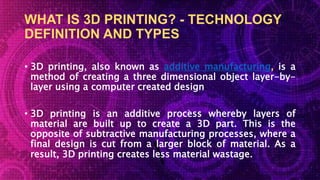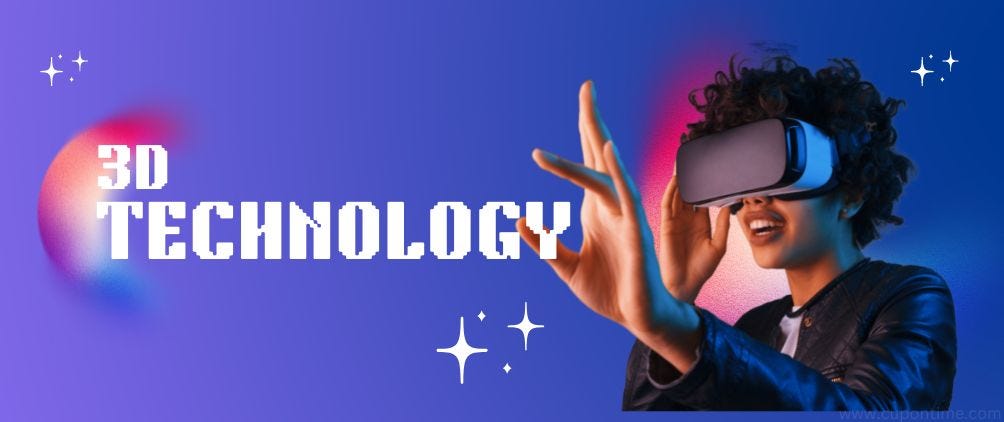What is 3D Printing? Unveiling Tech Wonders & Varieties
- Update Time : Friday, July 12, 2024

3D printing shines in making one-of-a-kind items. Users tailor products to their exact needs. This level of customization is unmatched in traditional manufacturing.
- Bespoke medical devices fit perfectly
- Unique gifts carry personal touches
- Designers tweak prototypes on the fly
Material Limitations
Materials can limit what you print. Not all materials print well. Some are too brittle or too flexible.
Different materials have different needs. Heat, pressure, and treatment vary.
- Plastics are common but vary in strength and flexibility.
- Metals require special printers. They are costly.
- Bio-materials are for specific uses. They need careful handling.
Cost Factors
Cost affects. Printers, materials, and operation add up.
| Item | Cost |
|---|---|
| Printer | $200 – $5000 |
| Materials | $20 – $100 per kg |
| Operation | Depends on use |
Ethical And Legal Considerations
With growth come challenges. Key concerns include:
- Copyright issues: Protecting designs is vital.
- Privacy concerns: Custom prints may raise questions.
- Regulations: Laws must keep up with technology.
Frequently Asked Questions
What Is 3d Technology?
3D technology creates or displays images with a perception of depth, often using special glasses or screens. It’s widely used in movies, gaming, and printing.
Conclusion
3D printing revolutionizes manufacturing and design with limitless possibilities from prototyping to production, shaping the future for tech enthusiasts.
3D printing, or additive manufacturing, is a process of making three-dimensional solid objects from a digital file. It involves adding material layer by layer to create an object.
3D printing has revolutionized manufacturing by allowing for rapid prototyping and complex design production that was previously unattainable. This technology empowers creators to bring digital concepts into the tangible world with precision. The types of 3D printing technologies vary, including Fused Deposition Modeling (FDM), Stereolithography (SLA), and Selective Laser Sintering (SLS), each suited to different applications.
FDM, the most common type, heats and extrudes thermoplastic filaments, while SLA uses a laser to cure liquid resin into hardened plastic. SLS, on the other hand, fuses powder particles together using a laser. These methods serve industries ranging from aerospace to healthcare, offering customization and flexibility in production. As the technology continues to evolve, its impact on the future of manufacturing and design is set to grow exponentially.

Credit: www.slideshare.net
The Genesis Of 3d Printing
The story of 3D printing began over 30 years ago. It has transformed from a concept to a game-changing technology. This journey is filled with innovation and creativity.
From Concept To Reality
The idea of creating three-dimensional objects from digital models was once a dream. Today, it’s a reality that impacts many industries. The technology allows for the production of complex designs with precision.
Key Milestones In 3d Printing History
The timeline of 3D printing is marked by significant achievements. These milestones have paved the way for current advancements.
- 1984: The invention of stereolithography (SLA).
- 1992: The first 3D printed part using SLA was created.
- 1999: The first 3D printed organ was implanted.
- 2009: The entry of affordable 3D printers into the market.
- 2012: 3D printing with metal became possible.

Credit: medium.com
Decoding 3d Printing
Decoding 3D Printing reveals the future of manufacturing. This innovative process transforms digital designs into tangible objects. It is changing how we create, from toys to houses.
Basic Principles
At its core, 3D printing builds objects layer by layer. Each layer bonds to the previous one. This creates a three-dimensional product from the bottom up.
- Design: Starts with a digital 3D model.
- Slicing: The model gets divided into thin layers.
- Printing: Layers are printed one at a time.
How A 3d Printer Works
A 3D printer reads the sliced model. It then deposits material accordingly. The process repeats until the object is complete.
| Step | Action |
|---|---|
| 1 | Prepare the 3D file |
| 2 | Slice the model |
| 3 | Start the 3D print |
| 4 | Layer by layer building |
| 5 | Remove completed object |
Types Of 3d Printing Technologies
3D printing offers various technologies with distinct materials and processes, including common types.
Stereolithography (SLA)
Stereolithography, or SLA, is a pioneer in 3D printing. It uses a laser to cure liquid resin into hardened plastic. This process happens layer by layer. SLA is known for high precision and smooth finishes. Here are some key points:
- High detail: Perfect for complex designs.
- Smooth surfaces: Fewer visible layers.
- Versatile materials: Suitable for various applications.
Fused Deposition Modeling (fdm)
Fused Deposition Modeling, known as FDM, is widely used. It heats and extrudes thermoplastic filaments. The material is laid down layer by layer. FDM is great for functional prototypes. It is cost-effective and user-friendly. Here’s what makes FDM stand out:
- Material variety: Many plastic types available.
- Accessibility: Easy to use at home or in schools.
- Economical: Lower cost for entry-level printing.
Selective Laser Sintering (sls)
Selective Laser Sintering, or SLS, is powerful. It uses lasers to fuse powder particles together. SLS doesn’t need support structures. It’s good for complex geometries. SLS prints are durable and versatile. Key features include:
| Feature | Benefit |
|---|---|
| No support needed | Prints intricate designs with ease. |
| Durable parts | Suitable for functional prototypes. |
| Wide material selection | Works with a range of powders. |

Credit: in.pinterest.com
Materials In 3d Printing
3D printing turns digital designs into real objects with specialized materials. Let’s look at common 3D printing materials.
Plastics And Polymers
Plastics are widely used in 3D printing. They come in various forms:
- ABS (Acrylonitrile Butadiene Styrene) – tough and durable.
- PLA (Polylactic Acid) – biodegradable and user-friendly.
- PETG (Polyethylene Terephthalate Glycol) – strong and flexible.
These materials are perfect for prototypes, toys, and home items.
Metals
3D printing with metals offers strength and durability. Common metals include:
- Stainless Steel – corrosion-resistant.
- Aluminum – lightweight and strong.
- Titanium – high strength-to-weight ratio.
Metal printing is ideal for aerospace and medical implants.
Ceramics And Other Advanced Materials
Ceramics are used for their heat resistance and finish. Other advanced materials include:
- Graphene – conducts electricity.
- Wood Filament – wood-like finish.
- Conductive Ink – for electronic circuits.
These materials open new possibilities for 3D printed objects.
3D printing shines in making one-of-a-kind items. Users tailor products to their exact needs. This level of customization is unmatched in traditional manufacturing.
- Bespoke medical devices fit perfectly
- Unique gifts carry personal touches
- Designers tweak prototypes on the fly
Material Limitations
Materials can limit what you print. Not all materials print well. Some are too brittle or too flexible.
Different materials have different needs. Heat, pressure, and treatment vary.
- Plastics are common but vary in strength and flexibility.
- Metals require special printers. They are costly.
- Bio-materials are for specific uses. They need careful handling.
Cost Factors
Cost affects. Printers, materials, and operation add up.
| Item | Cost |
|---|---|
| Printer | $200 – $5000 |
| Materials | $20 – $100 per kg |
| Operation | Depends on use |
Ethical And Legal Considerations
With growth come challenges. Key concerns include:
- Copyright issues: Protecting designs is vital.
- Privacy concerns: Custom prints may raise questions.
- Regulations: Laws must keep up with technology.
Frequently Asked Questions
What Is 3d Technology?
3D technology creates or displays images with a perception of depth, often using special glasses or screens. It’s widely used in movies, gaming, and printing.
Conclusion
3D printing revolutionizes manufacturing and design with limitless possibilities from prototyping to production, shaping the future for tech enthusiasts.


















Leave a Reply